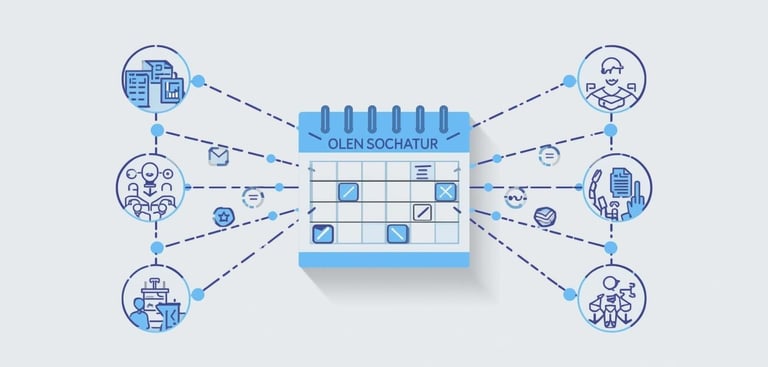Start sending invites for free - no card required - Click here
The Smarter Way to Organize Meetings Simplifying Bulk Calendar Invites
Scheduling meetings should bring people together, not cause confusion. Yet, in many workplaces, coordinating multiple calendars across departments, time zones, and availability still feels like an uphill task. Whether you’re planning a product demo, a corporate briefing, or a large online session, knowing how to send bulk calendar invites efficiently can make a world of difference.
BLOGS
10/13/20253 min read


Scheduling meetings should bring people together, not cause confusion. Yet, in many workplaces, coordinating multiple calendars across departments, time zones, and availability still feels like an uphill task. Whether you’re planning a product demo, a corporate briefing, or a large online session, knowing how to send bulk calendar invites efficiently can make a world of difference.
In this blog, we’ll explore how bulk calendar scheduling enhances productivity, saves valuable time, and helps create smoother communication across teams without depending on complex tools or systems.
Why Coordinated Scheduling Matters
Meetings are the foundation of collaboration. But without structure, they can quickly become a source of frustration.
Poorly organized meetings often lead to:
Missed invites or overlapping sessions
Miscommunication about timing
Low attendance and wasted preparation time
When you learn how to send multiple calendar invites effectively, you take control of your scheduling environment. Every participant receives consistent details time, date, agenda, and location making the process transparent and predictable.
The Modern Shift to Calendar-Centric Workflows
As digital collaboration becomes standard, calendars have evolved into central planning hubs. Employees no longer rely on endless email threads or scattered messages to track events. Instead, calendar platforms provide an integrated view of daily priorities.
When organizations adapt to this workflow, they can plan their activities more strategically. Weekly check-ins, cross-team syncs, and client sessions are all neatly structured and visible, helping everyone stay aligned and accountable.
What Makes Bulk Invitations Efficient
Sending individual invites may work for small teams, but it’s impractical for larger organizations or recurring events. That’s where the concept of send mass calendar invite comes in, allowing one standardized invitation to reach dozens or even hundreds of recipients at once.
The key benefits of bulk invitations include:
Speed: Save hours that would otherwise be spent adding contacts manually.
Accuracy: Minimize errors like missing addresses or wrong dates.
Consistency: Everyone receives the same information at the same time.
Flexibility: Easily update meeting details for all participants simultaneously.
Bulk scheduling is particularly useful for team-wide announcements, company town halls, and training programs where consistency is critical.
Structuring a Clear and Effective Invite
Even the most efficient scheduling system can fall short if the invitation isn’t clear. Here’s what to include in a professional calendar invite:
Concise subject line: Clearly define the meeting’s purpose.
Agenda summary: Outline discussion points briefly.
Accurate time and location: Always mention the time zone to avoid confusion.
Additional resources: Attach files or provide meeting links.
Action note: Indicate if attendance confirmation is required.
Remember a well-written invitation sets expectations and encourages timely participation.
Scheduling at Scale in Business Environments
Corporate environments often rely on shared digital ecosystems like Microsoft 365, where scheduling large meetings is a daily task. Managing bulk meeting invites in O365 is a practical example of how enterprises handle internal communication at scale.
In such setups, administrators can use predefined groups, recurring events, and automated updates to streamline coordination. It’s less about technology and more about the process using digital calendars as the backbone for transparent, time-efficient collaboration.
Avoiding Common Pitfalls
Even experienced professionals can make scheduling mistakes that affect participation. Here are a few tips to prevent them:
Double-check for conflicting appointments.
Keep meeting lengths reasonable to maintain focus.
Always verify contact lists before sending bulk invites.
Include reminders to boost attendance rates.
Simple precautions go a long way toward ensuring your meetings remain smooth and effective.
The Human Side of Scheduling
Beyond automation and organization, meeting invites represent communication between people. Consider the human aspect of timing preferences, workloads, and time zones to make your scheduling more considerate and inclusive.
Small gestures, such as scheduling breaks between sessions or avoiding end-of-day meetings, show respect for your team’s well-being.
Conclusion
Learning how to send bulk calendar invites efficiently isn’t just a productivity hack, it's a professional skill that improves coordination and strengthens teamwork. Whether you’re managing internal updates or external collaborations, well-organized scheduling ensures everyone stays informed and aligned.
From recurring check-ins to multi-department meetings, mastering the art of send mass calendar invite processes helps create an environment where communication is structured, time is respected, and productivity thrives.
BulkCalendar.in
Send Bulk & Mass Calendar Invites Instantly
Contact us
Engagement
sales@letscalendar.com
+44 (0) 203 916 5117
© 2025. All rights reserved.
Help?
